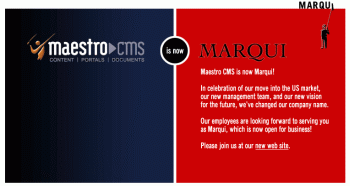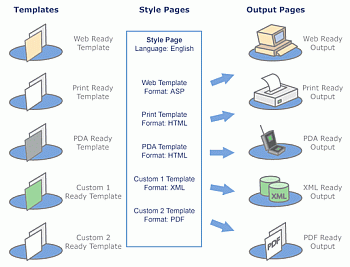Content Publishing Abilities: Marqui CMS Review - Part III
Marqui is an online-based content management system. I am on paid assignment to review and analyze their technology and this is my third article covering it.

In my introductory article I have set out the basic requirements that a Web-enabled organization would likely define when needing to tackle the effective selection of their ideal CMS solution.
Today, I am looking at the Marqui CMS from the specific point of view of how well it meets my reference set of CMS publishing requirements.
As defined in Part I of this article series, these are:
a) Style sheets
b) Page templates
c) Extensibility
d) Support for multiple formats
e) Personalization
f) Usage statistics
So, how well does Marqui perform at each one of these?
Publishing Requirements
a) Style sheets
With the Marqui CMS you can use CSS style sheets as you do with any other Web site to control the look and feel of all sections of your it, including the Marqui interactive menu system. Style sheets provide the ability to control globally the look and feel of a Web site, allowing non-technical users to concentrate on content creation.
Marqui's interactive Menu Builder is another powerful feature that generates site navigation menus automatically when a user adds or deletes a page or section of the Web site. It automatically generates the HTML code required to display the interactive menu vertically and the output of this HTML can be controlled itself by a CSS style sheet. When the CSS is updated, all the menus are updated with the new changes in the CSS file.
b) Page templates
The Marqui CMS system offers full support for the use of page templates. Marqui, like most other CMS systems does not provide an integral page template editor, and allows final users to work with their favourite page design application, while importing the final results in Marqui for implementation as templates.
The Marqui CMS also integrates Style Pages which facilitate the application and use of page templates. Unlike templates, Style Pages do not contain actual formatting code of an output page. Style Pages only contain references to Templates to be used and settings needed by multiple output pages.
"Used for regular output pages, the normal style page allows the user to set up what final output pages look and feel by associating formatting specifications with content. Style pages act basically as pointers that determine which templates to use for each output page being published.
Marqui Page Templates contain source code (HTML or any other language) as well as "extensibility components" (see further below) which do guarantee total separation of content from design.
Some typical templates used by the Marqui system are:
a) the Web Ready Template (for input and output)
The Web ready template publishes the Web view of your site (Internet, Intranet, or Extranet) and also defines the end-user interface.
b) the Print Ready Template (Output only)
The print ready template is optimized for print outout and therefore it contains all of the Web content less all the graphics and table size restrictions that interfere with print-style output.
c) PDA Ready Template (Output only)
The PDA ready template is used to output content in WML format, ready for display on any WAP-enabled client, or to 200x600 formatted HTML content for optimized display hand-held computers.
d) Customizable Templates (Output only)
Custom templates can be used to publish content to any other possible output format such as Web Services / SOAP, XML ready output, where other third-party applications can reuse it for other purposes.
Remember that in the Marqui CMS system Templates are fully complemented by Style Pages which extend their flexibility and range of applications (read further below).
c) Extensibility
The Marqui CMS does provide quite a bit of flexibility and easy-of-use in making it as simple as possible to integrate code "snippets" inside page templates to provide additional publishing functionalities. This capacity provides the Marqui CMS administrators to self-improve and optimize their own interface and the ones of the contributing editors in many useful ways.
Marqui provides so-called WXGET Placeholders and WX Inserts to allow further customization of any page template by pre-designating content sections where content will be input or other more sophisticated programmatic operations dedicated to select what content to show in a certain section of the page depending on a set of selected conditions.
"In addition to acting as variables, WXGET placeholders also configure the system's end user interface or GUI (Graphical User Interface). They contain properties that can be evoked to generate text boxes, drop-down lists, formatting buttons, etc. WXGET placeholders are used to modify the user interface within the application where content contributors manage their content pages. WXGET placeholders allow Admin users to create input text boxes, manage their behavior (e.g., formatting), and create drop-down lists, selection lists, etc. WXGET placeholders have a series of properties that will modify the behavior of each placeholder, explained below."
d) Support for multiple formats
With the Marqui CMS the publishing organization becomes indeed format independent allowing complete freedom of output to an extensive number of publishing standards including HTML (Web), PDF, RSS, XML, text, Word and more.
Due to its core nature based on XML content the Marqui CMS also allows further extensibility of such output functionality to cover most any required other publishing format.
Style Pages are created whenever there is a unique series of output pages requiring a different output template. The Style Page points in fact to one or multiple templates that determine the format and layout of the final output pages. As each style page can reference up to five different templates content can be published in many different formats.
Three typical Style Pages that are integral part of the Marqui CMS are:
a) the Normal Style Pages which are used to create normal Web pages,
b) the Calendar Event Style Pages which are used to create pages that include the ability to send e-mails to subscriber's lists, while updating specific content sections on the site.
c) the E-mail Style Pages which are used to create e-mail communications that are not be published on the Web.

e) Personalization
The Marqui CMS allows basic personalization of content published by way of its Secure folders functionality. With it, designated content folders can be secured and made to be accessible only to selected groups of users.
This allows the creation of "Members-only" areas, or to restricted content sections accessible only to certain groups. Groups can easily be created and new users assigned to them.
f) Usage statistics
The Marqui CMS system leaves to its third-party integrators the choice of which traffic monitoring system to use.
The 'Analyzer' button provided in the main Marqui user interface is pre-set to be linked by the Marqui "integrator" (the company/consultant who will sell, install and configure the Marqui CMS for your organization) to their selected tracking/monitoring system of choice.
Stay tuned for more.
In the next Part, I will be looking at how well the Marqui online CMS meets the Accessibility requirements set out in Part I.


blog comments powered by Disqus